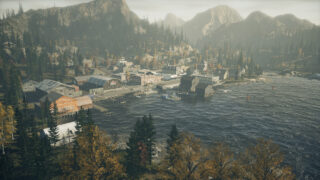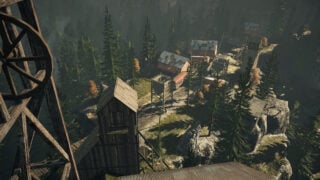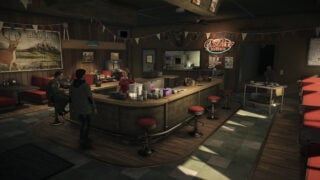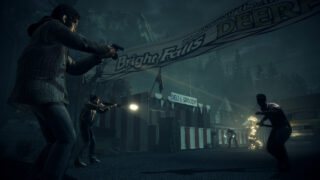Review: Alan Wake Remastered shines a new light on an old friend
Remedy’s dingy delight is rare remaster that earns its keep
- Creative director
- Sam Lake
- Key Credits
- Mikael Kasurinen (Designer)

Where many remasters are simple nostalgia plays – or crude cash grabs – Alan Wake feels like a spit and polish job that almost had to happen.
With the second Control expansion, AWE, came the reveal of the Remedy Connected Universe – think the MCU with added offbeat Finnish humour. And with that came a reason for Remedy to drag their 2010 survival horror into the modern generation: Alan Wake is now a key chapter of a bigger narrative project, so it makes sense for it to be readily available for all. It’s also an opportunity to push an already flashy game a little harder, using modern console juice.
In a new commentary for the game, creative director Sam Lake is keen to highlight that this is a remaster, not a remake. It sounds slightly defensive when he says it, like he’s setting modest expectations. There’s actually no need for it. A boost in resolution, frame rate and some lighting tweaks is enough for this handsome game to hold its own in 2021. You might have hoped for some HDR or ray-tracing, given the gameplay’s focus on light and dark, but this pops on screen without any of that.
It definitely benefits from much of the game being shrouded in inky night. Remasters often stumble by applying 4K scrutiny to worlds where fuzzy resolutions could hide a multitude of sins. The murky parts of Alan Wake look sensationally good, with his torch beam slicing through the shadows with such definition you’d be forgiven for thinking it was using HDR. Although in the harsh light of daytime, and a level set in the blockier town of Bright Falls, that sharper geometry does show its age a bit more.
The boosted frame rate (on new consoles, at least) really gels with action that’s often style over substance. The core loop of Alan Wake is shining a torch on shadow monsters to weaken them and then shattering them into glittering shards with a bullet. It’s pretty monotonous, but damn is it pretty: fizzing sparks of light, bursts of slow mo as enemies explode like fireworks, a 360-degree camera spin as a flare ignites a whole gang… what could stumble on Xbox 360 looks glorious here.
Where many remasters go to great lengths only for the game to look ‘how you remember it’ – the curse of rose-tinted glasses – Alan Wake does look tangibly modern. If you were playing this as part of a wider Remedy replay, it wouldn’t feel or look like much of a step down from Control in many places.
It isn’t perfect, though. As mentioned, the story interludes set during the day show their age with sparser buildings and some dead-eyed character models. A bigger problem is that the playable action now looks so slick that the cutscenes look worse by comparison. Suddenly watching action at a lower frame rate and minus the pinsharp clarity is pretty jarring. A real shame as the character models and lip-synching are improved, but the overall effect is underwhelming.
“Alan Wake does look tangibly modern. If you were playing this as part of a wider Remedy replay, it wouldn’t feel or look like much of a step down from Control in many places.”
You might also wish for a better solution for the developer commentary than the auto-playing clips. The game has two tracks – a design breakdown from the original collector’s edition and new Sam Lake VO that dives into his writing process and Wake’s role in the Remedy universe. But many trigger in busy scenes, leaving the analysis to battle against in-game dialogue or, worse, distract you from the fight you’re in. It’s a surprisingly clumsy execution of an otherwise tasty extra.
Of course, that level of designer insight is aimed at the Alan Wake fans. Newbies coming to this fresh get to discover an unusual take on survival horror, one that is much an interactive movie as it is straight spook-em-up. Back in 2010 this hybrid storytelling probably seemed more out there and cutting edge. Now, in the age where even Kratos pauses for slow, talky bits, Alan Wake’s more televisual pacing seems like quaint foreshadowing of things to come.
Which ties in nicely to one of the game’s better gimmicks: that Alan Wake, a writer, is (maybe) trapped in a story of his own creation, meaning he’s constantly discovering manuscript pages that cryptically hint at plot events to come (or offer insight into events you’ve witnessed). It’s written as a naff Stephen King pastiche, but that extra layer of pulpy oddness means Alan Wake still has a distinct voice. Other games may have borrowed his narrative tricks, but few are having this much fun with it.

As mentioned, the action is flashy if one note. Limited enemy and weapon types mean you quickly learn to lean on certain tactics, and the fact that many fights take place in whirling shadow storms means they visually blur together. The game also has a tiresome habit of stripping Alan of his torch and arsenal and forcing him to gradually collect them over the course of a level, giving his journey a sense of stalling progress rather than one satisfying power curve from start to finish.
Remedy makes up for that shortcoming with a story that whisks you between varied locations and regularly pairs Alan with a fun cast of NPC allies. There’s a particularly strong scene involving a farm, complete with a possessed combine harvester and a siege amidst the pyrotechnics of a rock concert. This marks the turning point in a campaign that gets a lot sillier, and more enjoyable, as it goes. Get Alan tooled up in the final stretch and problems melt away as easily as the shadow monsters.
There’s other unevenness here – the game’s open world origins are still felt in some bloated landscapes with nothing to do but drive through them on the way to the next linear level – but these are quirks better tackled in a sequel rather than huge pitfalls that derail this adventure. Alan Wake is fundamentally an entertaining trip through a hokey thriller that has proven itself to have great sticking power, and thanks to the RCU, a key role to play in their future games.
Where you land on the remaster, and whether to justify a purchase, depends on your past with the game. At the top of the pile are PlayStation owners, who get to experience Alan’s misty mystery for the first time and in a very shiny form to boot. They’re followed by Xbox Series S/X players who get to see what the 2010 release really should have looked like. But for PC owners there’s not a great leap from what is already available on Steam for half the price.
Alan Wake Remastered will mean different things to different people. A fond revisit to pulp horror gem. A late discovery of a game freed from exclusivity. Or perhaps the missing piece of a vast multi-franchise narrative puzzle. Crucially, there is plenty of entertainment in them all. This is clearly not the last we’ll see of Alan Wake, so what better time to get reacquainted?
An uneven action experience gets by on a huge amount of charm and a gorgeous visual treatment that more than holds its own ten years later.
- Flashy (and flashbang-y) combat has never looked better
- A love letter to pulpy thriller writing
- Not Remedy’s greatest combat system
- Cutscenes not consistent with the rest of the remaster

























